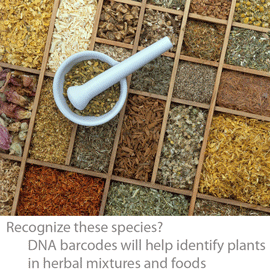Botanists establish DNA barcode for land plants
In this week’s Proc Natl Acad Sci USA, CBOL Plant Working Group, which included 52 researchers from 25 institutions, announced agreement on a DNA barcode for land plants. The authors tell their story:
 “DNA barcoding involves sequencing a standard region of DNA as a tool for species identification. However, there has been no agreement on which region(s) should be used for barcoding land plants. To provide a community recommendation on a standard plant barcode, we have compared the performance of 7 leading candidate plastid DNA regions (atpF–atpH spacer, matK gene, rbcL gene, rpoB gene, rpoC1 gene, psbK–psbI spacer, and trnH–psbA spacer). Based on assessments of recoverability, sequence quality, and levels of species discrimination, we recommend the 2-locus combination of rbcL and matK as the plant barcode. This core 2-locus barcode will provide a universal framework for the routine use of DNA sequence data to identify specimens and contribute toward the discovery of overlooked species of land plants.”
“DNA barcoding involves sequencing a standard region of DNA as a tool for species identification. However, there has been no agreement on which region(s) should be used for barcoding land plants. To provide a community recommendation on a standard plant barcode, we have compared the performance of 7 leading candidate plastid DNA regions (atpF–atpH spacer, matK gene, rbcL gene, rpoB gene, rpoC1 gene, psbK–psbI spacer, and trnH–psbA spacer). Based on assessments of recoverability, sequence quality, and levels of species discrimination, we recommend the 2-locus combination of rbcL and matK as the plant barcode. This core 2-locus barcode will provide a universal framework for the routine use of DNA sequence data to identify specimens and contribute toward the discovery of overlooked species of land plants.”
The Working Group concludes: ” There is little doubt that the approaches used in plant DNA barcoding will be refined in the future. However, the key foundation step for plant barcoding is in reaching agreement on a standard set of loci to enable large-scale sequencing and the development of a global plant barcoding infrastructure. The broad community agreement presented here, to sequence rbcL and matK as a standard 2-locus barcode, is thus an important step in establishing a centralized plant barcode database as a tool for taxonomy, conservation, and the multitude of other applications that require identification of plant material.”
In the same issue of PNAS, a Commentary by Jesse Ausubel traces the development of DNA barcoding, from a proposal in 2003 for a standardized DNA-based approach to species identification, using mitochondrial COI gene for animal species. Adopting COI as a standard was the essential first step, leading to a rapidly growing library now with over 620,000 specimens from over 58,000 species, enabling high-school students to become identification experts for store-bought fish items and shedding new light on species diversity. With the publication of this paper, DNA-based identification for land plants is now poised to expand rapidly, with benefits to science and society. Ausubel views DNA barcoding enterprise as an urgently needed “macroscope” for probing ecological and evolutionary patterns on a broad scale. He concludes with a call “to accept the invitation of the 52 authors led by Hollingsworth to use the standard two-locus barcode of matkK and rbcL to join in building a powerful botanical macroscope.”
This entry was posted on Tuesday, August 4th, 2009 at 9:06 am and is filed under General. You can follow any responses to this entry through the RSS 2.0 feed. Both comments and pings are currently closed.